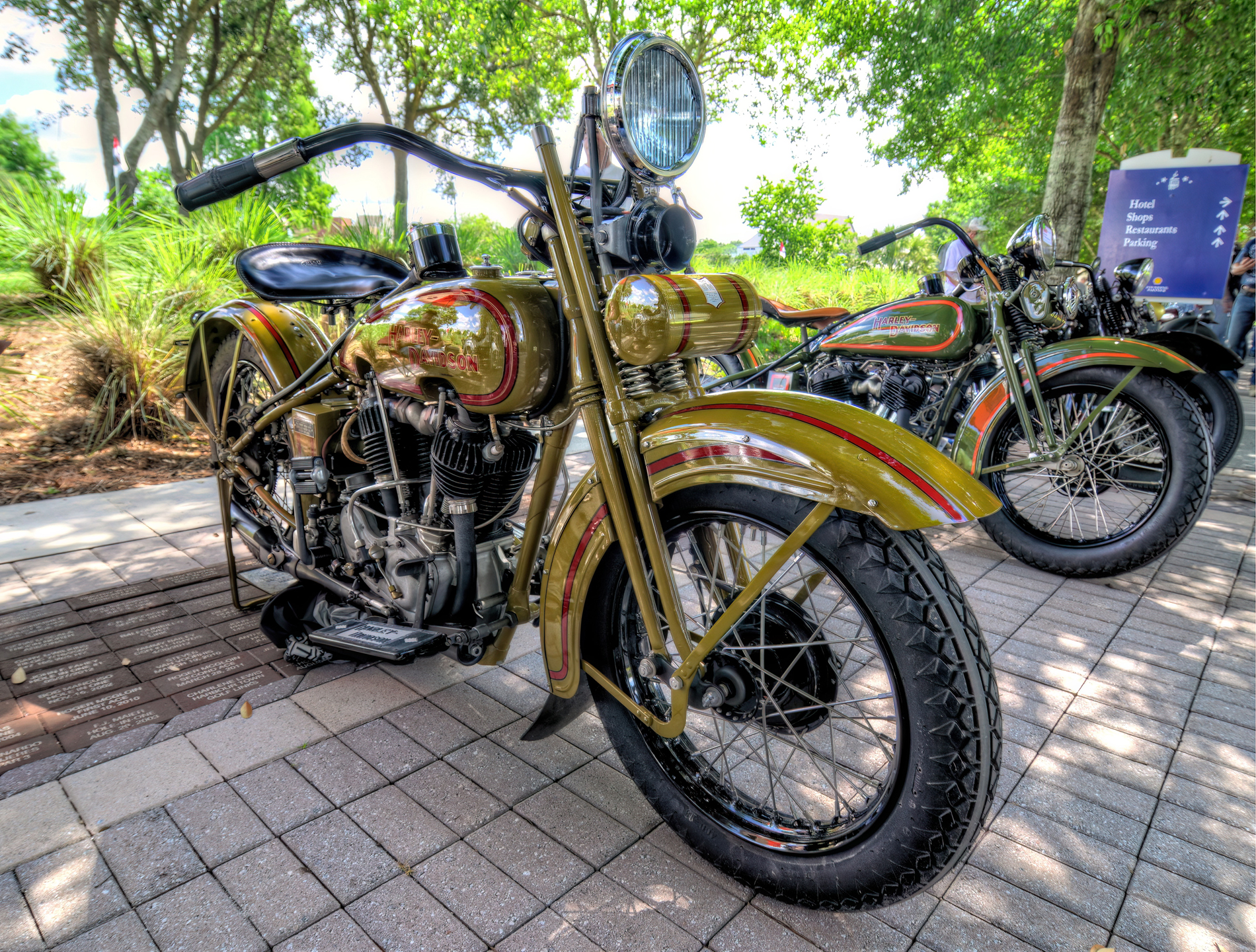
The 1926 Harley-Davidson Model J is a significant motorcycle from the early days of Harley-Davidson, representing a blend of innovation, reliability, and classic design.
1909 marked the appearance of Harley-Davidson’s first v-twin but it was not until the adoption of mechanically operated inlet valves in 1911 that replaced atmospheric type inherited from the single that production really took off. Known as the sobriquet ‘pocket valve’, this ‘F-head’ inlet-over-exhaust engine it was built in 61ci and 74ci capacities (1,000cc and 1,200cc) and would remain in production for the next 20 years. The Harley single’s transmission arrangements and direct drive with a leather belt were also continued at first on the twin, but the need to make better use of the engine’s power characteristics. This became particularly important for sidecar pulling and prompted the introduction of a two-speed rear hub in 1914, by which time chain drive and a proper clutch had also been adopted. Later that same year a conventional, three-speed, sliding-gear transmission with step starter was also introduced with full electrical equipment, listed as the Model J (61 ci) or JD (73 ci). Year by year the models were further developed and some of the new features for 1921 were one-piece tubular steel handlebars and full valences on front mudguard. 1921 was not a very good year for the company and from mid- March to mid- April the factory was actually temporarily closed down due to extremely low sales.
The 1926 Harley-Davidson Model J is a classic example of American motorcycle engineering and design from the mid-1920s. With its 74 cubic inch side-valve V-twin engine, classic cruiser design, and durable performance, it stands out as a significant model in Harley-Davidson’s history. The Model J’s legacy in the motorcycling world, combined with its appeal among collectors, makes it a cherished piece of vintage motorcycle history.
Background
- Manufacturer: Harley-Davidson
- Year: 1926
- Model: Model J
Specifications
- Engine: The 1926 Harley-Davidson Model J is powered by a 74 cubic inch (1207cc) side-valve (flathead) V-twin engine. This air-cooled, four-stroke engine was designed for durability and smooth operation, producing around 18-22 horsepower.
- Transmission: The motorcycle features a three-speed hand-shift transmission with a foot-operated clutch, which was standard for the period.
- Chassis: The Model J is built on a robust steel frame, designed to handle the weight and power of the large V-twin engine while providing a stable and comfortable ride.
- Suspension: The front suspension consists of a springer fork with a coil spring, while the rear features a rigid frame. This setup was typical of the era, offering a balance of comfort and control.
- Brakes: The motorcycle is equipped with drum brakes both at the front and rear, providing adequate stopping power for the time.
Design and Features
- Body Style: The Harley-Davidson Model J features a classic cruiser design, characterized by its large, teardrop-shaped fuel tank, wide handlebars, and substantial fenders. The design emphasizes both aesthetics and practicality.
- Design Elements: The motorcycle includes distinctive features such as the Harley-Davidson logo on the fuel tank, chrome accents, and spoked wheels. The attention to detail in the design reflects the brand’s commitment to quality and craftsmanship.
- Instrumentation: The Model J includes basic instrumentation, typically a speedometer and an ammeter, providing essential information to the rider.
Performance
- Speed: The Model J is capable of reaching speeds of around 60-70 mph (97-113 km/h), making it suitable for long-distance touring and highway cruising.
- Acceleration: The side-valve V-twin engine provides smooth and steady acceleration, ideal for the heavy cruiser. It offers a comfortable and enjoyable riding experience, particularly on longer rides.
- Handling: The Model J offers stable and predictable handling, thanks to its robust frame and well-balanced design. While it may not be as agile as lighter motorcycles, it provides a comfortable and controlled ride, especially on open roads.
Historical Significance
- Engineering Innovation: The 1926 Harley-Davidson Model J showcased significant engineering advancements, particularly in its engine design and overall reliability. The side-valve V-twin engine was renowned for its durability and ease of maintenance.
- Cultural Impact: The Model J became a symbol of American ingenuity and craftsmanship, contributing to the enduring legacy of Harley-Davidson as an iconic motorcycle brand.
- Military Use: The Model J was also utilized by the military, highlighting its reliability and versatility. It played a role in Harley-Davidson’s long-standing relationship with the armed forces.
Legacy
- Collector's Item: Today, the 1926 Harley-Davidson Model J is a highly sought-after collectible among vintage motorcycle enthusiasts. Its historical significance, engineering innovation, and classic design make it a valuable addition to any collection.
- Cultural Appreciation: The Model J is appreciated for its role in the development of Harley-Davidson motorcycles and its contribution to the rich history of motorcycling.
- Enduring Appeal: The bike’s combination of vintage aesthetics, reliable performance, and historical significance ensures its continued interest among collectors and motorcycle aficionados.
You may purchase a print of the 1926 Harley Davidson Model J in our Riding Into History d'Elegance 2016 online gallery.



